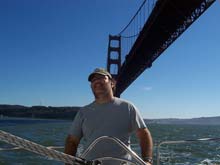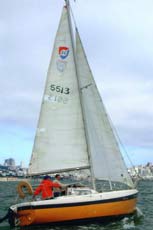My best "scared-at-sea" story is more Twilight Zone than Cape Fear. I've been sailing on San Francisco Bay for about 25 years now, but this particular trip happened early in my sailing career, when the dangers of transiting the "Golden Gate" itself loomed larger in my mind. San Francisco Bay serves up plenty of excitement with its high winds and tough tidal currents, but actually passing through the narrow Golden Gate accentuates all of that as the venturi effect of the entrance dramatically intensifies both. Tidal currents routinely run 3 and 4 knots and can exceed 6 knots at their peak. When a 20+ knot sea breeze coming in opposes a 4 or 5 knot ebb going out, the combination makes for a nasty gauntlet of steep nearly stationary waves ready to punish any small boat skipper who doesn't take time to triple check the tides and time their transit. Add a busy harbor worth of container ships, tankers and other traffic regularly passing through the same half mile opening to the sea, and you can understand why the transit might be intimidating for a novice.
 |
San Francisco Bay serves up plenty of excitement with its high winds and tough tidal currents, but actually passing through the narrow Golden Gate accentuates all of that as the venturi effect of the entrance dramatically intensifies both. |
My friend and I were doublehanding my 26 foot sloop across the Bay, admiring the spectacular views of the Golden Gate Bridge as we sailed parallel to the bridge, about two miles distant, to seaward of us. We were filled with youthful confidence, now veterans of dozens of Bay adventures. Double reefed in a strong breeze, with foam showing at the tops of the dark green waves and the jib already wet with spray nearly to the spreaders, we decided the moment might be right to make our first run out to sea under that bridge, a Bay rite of passage. The sun was shining in a blue sky. There was no shipping traffic in sight. We'd caught the last of the ebb (which would make for flatter water as the tide turned). The strong wind promised a quick round trip. Yes, the time was right. "Let's do it", was the word. We strapped the sails in tight, focused on our goal a few miles to windward in the strengthening wind, and set to work driving the 6,000 pound sloop hard to weather.
A half hour later, we were soaked to the skin from flying spray, the jib was wet to the masthead, and the whole boat glistened. We were fairly flying to weather, as we passed into the shadow of the bridge and craned our necks to watch the roadway pass hundreds of feet directly overhead as we sailed beneath it. We'd done it! The pride of making good time on the tough beat into a near gale had displaced our fear of the surroundings. We were super sailors! Ready for anything! What could go wrong, now, already at the Gate with just a token distance to go before turning triumphantly downwind back to the harbor?
Before we even cleared the shadow of the bridge, the heavy sloop slammed to a violent stop with a shuddering blow that reverberated through the rigging. In an instant, the fun was over and we realized we were all alone in a particularly unforgiving expanse of water, in big trouble. A look below showed we weren't making any water, a frantic run forward failed to reveal any obstacles hidden behind the jib. Time to take stock of the situation, which turned out to be strange indeed. The sails were taut and drawing, the wind was still howling over the deck, a perfect study in sail trim, but the boat was completely dead in the water. Not a ripple showed astern, no wake.
| In an instant, the fun was over and we realized we were all alone in a particularly unforgiving expanse of water, in big trouble. |
 |
"Should we put on our lifejackets?", asks my friend. "Wasn't planning on any swimming just yet...", I reply. "Keep quiet for a minute, I'm trying to think". And think I did. Walking slowly around the deck, staring incredulously at the dark green water all around, with no floating objects in sight, nothing we could have hit, and the boat still dead in the water. What on earth had happened? A collision I could understand, but what was wrong with the boat now?
"Maybe we ran aground", my friend offers. "In 300 feet of water?". "Maybe it's low tide". I resist the urge to snap back, knowing he's just trying to help. "Just let me think, already!". It's getting cold in the shadow of the bridge, and the wind feels more threatening as I numbly run through every trick in my book. I shake out the double reef, and try to trim the full main in the howling wind. The boat still won't answer the helm, and shows no wake astern. I fire up the outboard and rev it up to its full 9.9 horsepower output, admiring the swirling prop wash, but still no forward motion. I spin the wheel from one stop to the other, trying forward and reverse, pushing the boom forward to backwind the big main. Still nothing.
Time passes. Ten minutes, then fifteen, as I ineffectually try to free the boat. Still stuck solid. Directly beneath the Golden Gate Bridge. I'd wanted to see the bridge from that perspective, but hadn't planned on anything quite so permanent.
I visualize the boat's underwater appendages trying to imagine a calamity to account for what we're experiencing. Thinking to myself. The keel must still be in place, or we'd be upside down by now. What if it's badly twisted? No, it's a 2,000 pound hunk of iron, and would shear the keel bolts before deforming to that extent. Maybe it sheared off all but one bolt, and is twisting on the remaining one. I don't like that mental image at all, of the keel hanging by a thread. I pull up the cabin sole and check the keel bolts. All present, tight, and dry.
Putting my sanity aside, the "ran aground in 300 feet of water" theory is looking better and better. Extended boathook in hand, I probe the water around the boat, half expecting to feel the muddy bottom. I'm sure we're solidly caught on something. I begin to construct grandiose theories of errant navigation buoys held below the surface by hundreds of feet of chain, now wrapped around our keel. Or waterlogged shipping containers in suspension in the murky water. Or submarines.
Our situation is almost comical, if not unbelievable. A still life sailboat frozen in place at the precise point of maximum danger in the center of the narrow opening between the massive bridge towers, with a whole world of wind and waves rushing by around us, just waiting for a container ship or tanker to run us down. Even the boat's rolling seems too slow, somehow dampened compared to the waves around us. More time passes, and we're no further. The strong sea wind gets colder on our wet clothes, and nothing we try seems to have any effect. "Are you sure we're not aground?". Now I'm getting frustrated.
Then, out of the blue, a light begins to dawn on me. Literally. As we find ourselves passing out of the shadow and into the sunlight. Are we free and moving, now? No. With more futile revving and trimming I can tell the boat still won't respond at all to power or sail, but notice our perspective on the Golden Gate Bridge towers has visibly changed. Whatever it is we're hooked on, I can tell the tide has turned and now we and it are moving together, drifting in with the flood tide.
Now, I'm convinced of the "chain around the keel" theory (with perhaps just a small chance of a submarine) and set about to unwind the thing by turning the boat about its keel. Forgetting the useless rudder, I pivot the outboard on its mount, so the thrust is 90 degrees to port, and wind it up to full throttle. Slowly, very slowly, the boat begins to pivot round and round to port, with the big mainsail sheeted in tight heeling her hard first to one side and then the other on each rotation. Nothing. I pivot the motor 90 degrees the other way. I try forward and reverse. Nothing. We're just getting dizzy, slowly. And hungry. And cold.
Then, unexpectedly, on what seemed like the twentieth rotation with the motor roaring sideways in full reverse, the boat's motion suddenly changes, and we find ourselves fighting to control a badly overpowered boat taking off to weather with way too much mainsail up and the outboard screaming away at an odd angle.
It takes five minutes and an eighth of a mile for us to get the reef tucked back in, the motor shut down, and the boat back under way for the harbor. Enough of the Gate for one day. As we sail towards the harbor, we're talking about our odd experience and how with our hands so full when we finally broke free, we never got a chance to see what it actually was that we hit so hard and fought so long to get loose of.
I guessed we'd never know. Until just then we sailed past a massive thirty foot long, two foot square timber floating just barely awash in the waves, almost invisible. It had a clear dent in the exact middle where our keel had hit it square on. We even imagined we could see bottom paint where our boat must have ridden up until the keel struck, then pressed it down, holding it under the water for nearly half an hour, pinned against our bottom by its own buoyancy. The drag of the huge timber had prevented motion in any direction, but it had balanced so perfectly that not a trace of either end had shown above the surface.
Humbled as we were, we were a bit more so as we noticed that only the center portion of the timber was free of rusty hardware. Both ends fairly bristled with heavy rusted iron spikes from the timber's original use, maybe as a piece of a pier or other heavy seaside structure. Those spikes were at least an inch in diameter. We wondered how our drama might have unfolded if we'd hit that nearly immovable waterlogged timber "spikes on", a few feet to either side of where we struck. We sailed on in comparative silence, my sailing education having really just begun.
I've made many transits since, but even after all these years, as I pass into the shadow of the bridge, I find myself subconsciously waiting to hear "that noise" again. At least this time I'll be ready for it.
 |
I've made many transits since, but even after all these years, as I pass into the shadow of the bridge, I find myself subconsciously waiting to hear "that noise" again. At least this time I'll be ready for it. |
***** |

